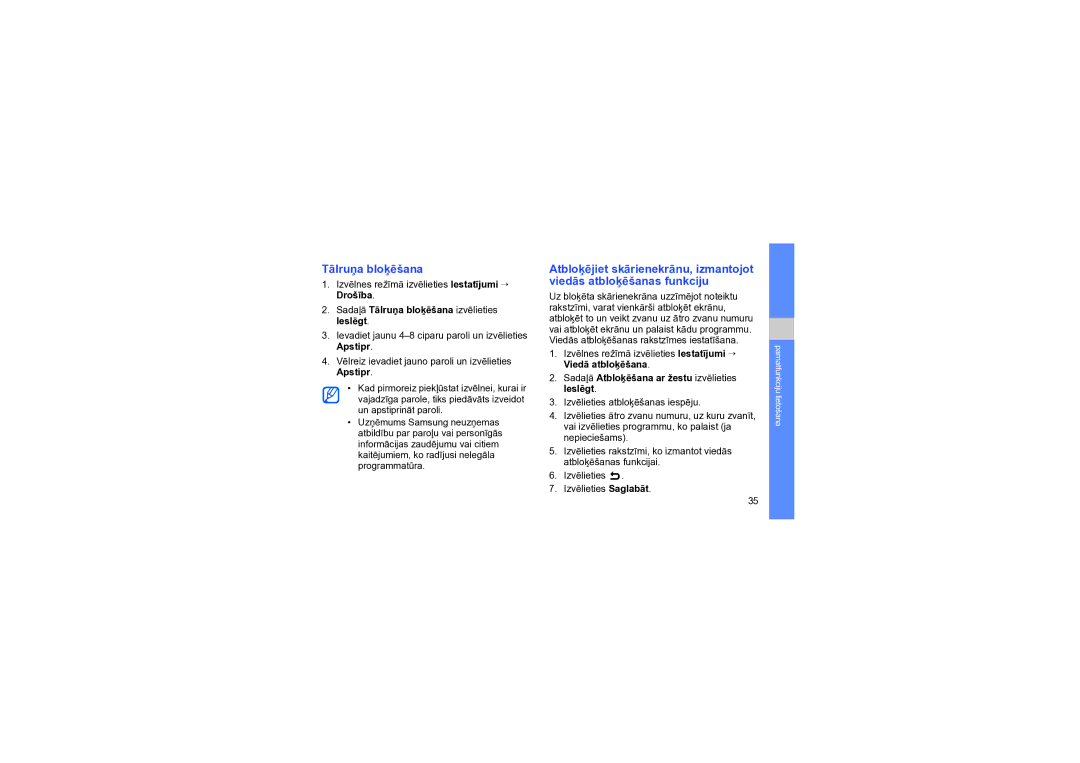Lietotāja rokasgrāmata
Norādījumu ikonas
Rokasgrāmatas lietošana
Informācija par autortiesībām
PAR Divx Video
Mobilā tālruņa Salikšana un sagatavošana
Iepazīšanās ar mobilo tālruni
Pamatfunkciju lietošana
Problēmu novēršana
Dzirdes aizsardzība
Drošības brīdinājumi
Piesardzība mobilo tālruņu un piederumu uzstādīšanā
Atkārtotu kustību izraisīto savainojumu riska mazināšana
Tālruņa izslēgšana sprādzienbīstamā vidē
Satiksmes drošība pirmajā vietā
Drošības pasākumi
Ievērojiet visus drošības brīdinājumus un noteikumus
Izmantojiet tikai Samsung apstiprinātos piederumus
Rīkojieties ar tālruni uzmanīgi un pareizi
Sargājiet akumulatorus un lādētājus no bojājumiem
Informācija par drošību un lietošanu
Lietojiet tālruni normālā stāvoklī
Svarīga lietošanas informācija
Tālruņa remontu drīkst veikt tikai kvalificēti speciālisti
Saudzīgi lietojiet SIM kartes un atmiņas kartes
Nodrošiniet piekļuvi avārijas dienestu pakalpojumiem
Izstrādājuma pareiza likvidēšana
Atruna
Šī izstrādājuma bateriju pareiza utilizācija
Page
Informācija par drošību un lietošanu
Komplektācija
Iepazīšanās ar mobilo tālruni
Tālruņa izkārtojums
Zvanīšana
Taustiņi
Uzziniet displejā redzamo ikonu nozīmi
Ikonas
Ikona Apraksts
SIM vai Usim kartes un akumulatora ievietošana
Mobilā tālruņa salikšana un sagatavošana
Ievietojiet SIM vai Usim karti
Akumulatora uzlāde
Zema uzlādes līmeņa indikators
Atmiņas kartes ievietošana papildiespēja
Atbloķējiet atmiņas kartes turētāju
Rokas siksniņas pievienošana papildiespēja
Pārslēgšanās uz bezsaistes profilu
Tālruņa ieslēgšana un izslēgšana
→ Bezsaistē
Skārienekrāna lietošana
Organizējiet lietojumprogrammas Izvēlņu režīmā
Piekļuve izvēlnēm
Kustības sensora lietošana
Programmu pārslēgšana
Pārslēgšanās no vienas aktīvas programmas uz citu
Programmu aizvēršana
Piekļuve programmai, pakustinot tālruni
Piekļuve programmai, izmantojot taustiņu Gate
Lai dezaktivētu kustību apmācību
Padomi kustību funkcijas lietošanai
Logrīku lietošana
Logrīku rīkjoslas atvēršana
Logrīku pārvietošana uz gaidīšanas ekrānu
Piekļūšana palīdzības informācijai
Logrīku mainīšana
Logrīku pakotņu izmantošana
Taustiņu toņu skaļuma pielāgošana
Tālruņa pielāgošana
Vibrācijas intensitātes pielāgošana skārienekrānā
Pārslēgšanās uz klusuma profilu un tā atcelšana
Aktivizējiet pieklājības pauzes funkciju
Zvana signāla maiņa
Fona attēla izvēle gaidīšanas režīmā
Izvēlieties Balss zvana signāls vai Video zvana signāls
Sadaļā Atbloķēšana ar žestu izvēlieties Ieslēgt
Tālruņa bloķēšana
Sadaļā Tālruņa bloķēšana izvēlieties Ieslēgt
Zvana veikšana
Galveno zvanīšanas funkciju lietošana
Atbildēšana uz zvanu
Skaļuma pielāgošana
Austiņu lietošana
Ziņu sūtīšana un apskatīšana
Īsziņu vai multiziņu sūtīšana
Izvēlieties Piesk., lai piev.adr. → Ievadīt manuāli
Ievadiet tekstu
Pasta ziņas sūtīšana
Izvēlieties Piev. multividi un pievienojiet objektu
Teksta ievades metodes maiņa
Teksta ievade, izmantojot pilno ekrānu
Teksta ievade, izmantojot tastatūru
Īsziņu vai multiziņu skatīšana
Kontaktu pievienošana un meklēšana
Pasta ziņas apskatīšana
Teksta ievade, izmantojot 1. rakstīšanas lodziņu
Jauna kontakta pievienošana
Galveno kameras funkciju lietošana
Kontakta atrašana
Fotoattēlu uzņemšana
→ Mani fotoattēli → un norādiet fotoattēla failu
Fotoattēlu apskatīšana
Videoklipu uzņemšana
Videoklipu apskatīšana
Mūzikas klausīšanās
Mūzikas failu klausīšanās
FM radio klausīšanās
Tīmekļa pārlūkošana
Grāmatzīmju veidošana biežāk apmeklētajām tīmekļa lapām
Google pakalpojumu izmantošana
Tīmekļa lapu pārlūkošana
Veidot savienojumu ar e-pastu
Veidot savienojumu ar meklētāju
Veidot savienojumu ar kartēm
Izvēlieties Izvēlne → Iegūt virzienus
Pēdējo zvanīto numuru izsaukšana
Papildu zvanīšanas funkciju lietošana
Neatbildēto zvanu apskatīšana un atzvanīšana
Otra zvana veikšana
Sarunas aizturēšana vai aizturētas sarunas atsākšana
Atbildēšana uz otru zvanu
Konferences zvana veikšana
Zvana atteikšana
Starptautiska numura izsaukšana
Zvanīšana kontaktam no tālruņu kataloga
Vizītkartes izveidošana
Tālruņu kataloga papildu funkciju lietošana
Izlases numuru iestatīšana
Izvēlieties Pievienot numuru
Izvēlieties Izveidot grupu
Kontaktu grupas izveidošana
Fotoattēlu un kontaktu saistīšana
Zvanu veikšana vai ziņu sūtīšana fotoattēlu režīmā
Papildu ziņapmaiņas funkciju lietošana
Teksta veidnes izveide
Multivides veidnes izveide
Mapes izveide ziņu pārvaldīšanai
Papildu kameras funkciju lietošana
Ziņas izveide, izmantojot multivides veidni
Uzņemiet fotoattēlus smaida uzņēmuma režīmā
Fotoattēlu sērijas uzņemšana
Panorāmas fotoattēlu uzņemšana
Fotoattēlu uzņemšana, izmantojot dekoratīvos rāmjus
Dalīto fotoattēlu uzņemšana
Kameras iespēju izmantošana
Videoklipu uzņemšana palēninājumā
Pielāgot
Pielāgojiet kameras uzstādījumus
Mūzikas failu kopēšana atmiņas kartē
Papildu mūzikas funkciju lietošana
Atskaņošanas saraksta izveide
Tālruņa sinhronizēšana ar programmu Windows Media Player
Mūzikas atskaņotāja iestatījumu pielāgošana
Piekļuve albumu sarakstam
Dziesmu ierakstīšana no FM radio
Izvēlieties Pievienot → Ieraksti
Izvēlieties Citi → Automātiskā staciju meklēšana
Radiostaciju automātiska saglabāšana
Mūzikas informācijas atrašana
Bezvadu funkcijas Bluetooth aktivizēšana
Bezvadu funkcijas Bluetooth lietošana
Datu sūtīšana, izmantojot bezvadu funkciju Bluetooth
Bluetooth ierīču meklēšana un savienošana pārī
Datu saņemšana, izmantojot bezvadu funkciju Bluetooth
Izvēlieties Sūtīt, izmantojot vai Sūtīt URL pa → Bluetooth
Sadaļā Attālais SIM režīms → Saglabāt
Wlan aktivizēšana
Wlan meklēšana un savienojuma izveide
SOS ziņu aktivizēšana un sūtīšana
Koplietojiet multivides datnes ar citām ierīcēm
Mobilā meklētāja aktivizēšana
Viltus zvanu veikšana
Tālruņa displeja apskatīšana TV ekrānā
Balss ierakstīšana
Balss piezīmju ierakstīšana un atskaņošana
Viltus zvana veikšana
Balss piezīmes ierakstīšana
Balss piezīmes atskaņošana
Attēlu rediģēšana
Efektu lietošana attēliem
→ Saglabāt kā
Attēla pārveidošana
Attēla pielāgošana
Attēla apgriešana
→ Saglabāt → Gatavs
Vizuāla līdzekļa ievietošana
Attēlu drukāšana
Piezīmes rokrakstā pievienošana
Izvēlieties Rediģēt → Ekrāna piezīme
Videoklipu rediģēšana
Izvēlieties Citi → Drukāt ar → Bluetooth
Segmentu apgriešana
Izvēlieties Faili → Importēt attēlu vai Importēt videoklipu
Izvēlieties Rediģēt → Ievietot → Teksts
Videoklipu atdalīšana
Teksta ievietošana
Skaņas ieraksta pievienošana
Fotoattēlu un videoklipu augšupielāde tīmeklī
Izlases adresātu saraksta iestatīšana
Izvēlieties Papildu audio ieraksts → Importēt skaņu
Faila augšupielāde
Java spēļu un programmu lietošana
Spēļu vai programmu lejupielāde
Izvēlieties Pieskarties, lai pievienotu un multivides failu
Spēļu spēlēšana
Datu sinhronizēšana
Programmu palaišana
Datu sinhronizācija ar tīmekļa serveri
Datu sinhronizācija ar Microsoft Exchange serveri
RSS plūsmu atjaunināšana un lasīšana
RSS plūsmu lietošana
RSS plūsmas adreses pievienošana
GPS funkciju atjaunināšana
Samsung mobilā navigatora palaišana
Pašreizējās atrašanās vietas apskate
Pasaules pulksteņa izveide
Pasaules pulksteņu izveide un apskatīšana
Pasaules pulksteņa apskate
Pasaules pulksteņa pievienošana displejam
Signālu iestatīšana un lietošana
Jauna signāla iestatīšana
Signāla pārtraukšana
Valūtu vai mērvienību konvertēšana
Kalkulatora lietošana
Atpakaļskaitīšanas taimera iestatīšana
Hronometra lietošana
Teksta piezīmju izveide
Jaunu uzdevumu izveide
Skiču izveide
Jaunas skices izveide
Kalendāra skata mainīšana
Kalendāra pārvaldīšana
Kustības pievienošana skicei
Izvēlieties Notikumu saraksts → norādiet notikuma veidu
Notikumu izveide
Notikumu apskate
Problēmu novēršana
Numurs pēc ievadīšanas netiek izsaukts
Jūs nevar sazvanīt
Jūtams, ka tālrunis ir sakarsis
Alfabētiskais rādītājs
Fotoattēli apskatīšana, 42 rediģēšana
Piezīme
Taustiņu toņi Tālruņa bloķēšana
Wi-Fi Windows Media Player
Mēs, Samsung Electronics
Atbilstības deklarācija R&TTE
Latvian /2009. Rev

